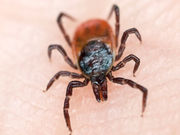~23.3 percent of ticks carry bacterial DNA from Rickettsia, Borrelia, and Ehrlichia spp.
THURSDAY, Jan. 14, 2016 (HealthDay News) — About 23 percent of ticks from Texas carry bacterial DNA from at least one of the following: Rickettsia, Borrelia, and Ehrlichia spp., according to a report published online Jan. 13 in the U.S. Centers for Disease Control and Prevention’s Emerging Infectious Diseases.
Elizabeth A. Mitchell, from the University of North Texas Health Science Center in Fort Worth, and colleagues describe the presence and distribution of tickborne bacteria and their vectors in Texas. They screened ticks collected from humans during 2008 to 2014 for Rickettsia, Borrelia, and Ehrlichia spp.
The researchers identified 13 tick species and screened DNA from each specimen. The most common species were Amblyomma americanum (55.7 percent), followed by Dermacentor variabilis and Rhipicephalus sanguineus (15.0 and 13.0 percent, respectively). About 23.3 percent of the ticks originating in Texas tested positive for Rickettsia, Borrelia, and Ehrlichia DNA. Most of these bacteria belonged to spotted fever group rickettsiae (SFGR). The most common tick species found to carry an SFGR agent was Amblyomma americanum.
“Our findings underscore the importance of better characterization and continued surveillance of the frequency and distribution of tick species and the bacterial agents they carry,” the authors write. “Continued monitoring in low-risk areas provides data regarding the presence of potential emerging pathogens and vectors not yet commonly identified, which could pose unidentified threats to public health.”
Full Text
Copyright © 2016 HealthDay. All rights reserved.








